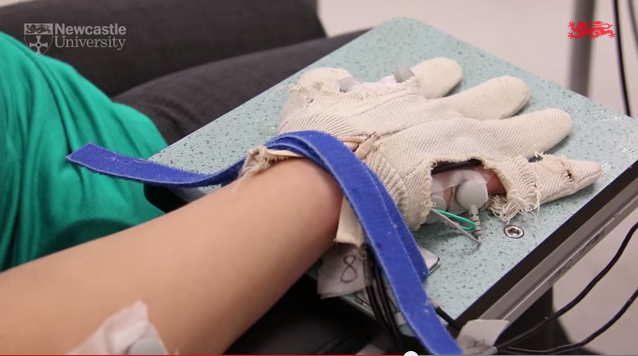Spinal Cord Stimulation Could Restore Movement In Paralyzed Extremities Within 5 Years

Patients who suffer a complete spinal injury lose all sensory and motor function below the level of injury and generally never regain the ability to move their extremities. Rehabilitation programs have been successful in limiting the extent of the damage and restoring some movement abilities. However, there is currently no available cure for returning full motor function to arms, hands, or legs. Researchers at Newcastle University have used spinal cord stimulation to regain motion in a paralyzed hand and hope their efforts will result in a viable treatment for paralysis within five years.
“When someone has a damaged motor cortex or spinal cord the problem is that the signal from the brain to the muscles isn’t getting through,” Research Fellow at Newcastle University, Dr. Andrew Jackson, said in a statement. “What we have done here is restore that connection, to allow the signal telling the hand to move to reach the spinal cord. By exploiting surviving neural networks below the injury, we can activate natural actions like grasping using just a few stimulation sites. This is the first time that anyone has done that.”
Jackson along with his colleague from Brown University, Dr. Jonas Zimmermann, trained macaque monkeys to grab and pull a spring-loaded handle. Next, the research team used a drug that caused the primates to retain normal brain functionality but lose control of their ability to move their hands and grasp objects for around two hours. Using a stimulation circuit that connected the brain to a computer and the computer back to the spinal cord, researchers observed the monkey regain hand movement and pull the handle.
“Much of the technology we used for this is already being used separately in patients today, and has been proven to work. We just needed to bring it all together,” Jackson added. “I think within five years we could have an implant which is ready for people. And what is exciting about this technology is that it would not just be useful for people with spinal injuries but also people who have suffered from a stroke and have impaired movement due to that. There are some technical challenges which we have to overcome, as there is with any new technology, but we are making good progress.”
Experts in spinal cord injuries say this groundbreaking discovery could open a world of possibilities in treatment options for patients who have suffered a stroke or a complete injury to the spinal cord. Jackson and Zimmermann say the next step in their research will be developing a small implantable chip that can link a patient’s brain to their muscles and restore motor function.
“Being able to restore dexterous hand movements to patients paralyzed by stroke or spinal cord injury would be a huge improvement to their independence and quality of life,” explained Dr. John Williams, head of neuroscience and mental health at the Wellcome Trust. “The Newcastle University team’s research, which harnesses the intact portions of the nervous system and creates new artificial connections, is at the cutting edge of neuro and rehabilitation science. When used alone or in combination with other rehabilitation approaches, this technique could lead to significant improvements in hand function and transform the lives of paralyzed patients.”
Source: Zimmermann J, Jackson A. Closed-loop control of spinal cord stimulation to restore hand function after paralysis. Frontiers in Neuroscience. 2014.
Published by Medicaldaily.com



























